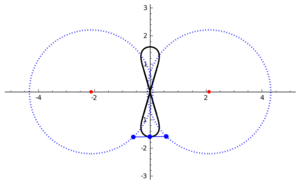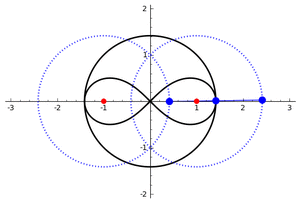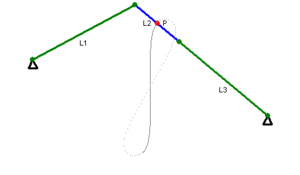Watt's curve facts for kids
Watt's curve is a special shape in mathematics. It's a type of curve that you can draw using a simple setup. Imagine two circles that are a certain distance apart. Then, picture a straight rod connecting a point on each circle. If you trace the exact middle point of this rod as the circles spin, you'll draw a Watt's curve!
This curve is named after James Watt, a famous inventor. He used a similar idea in his amazing work on the steam engine.
How the Curve Looks
The shape of a Watt's curve changes depending on the sizes of the circles and the connecting rod. Let's call the distance between the centers of the circles 2a, the radius of each circle b, and the length of the connecting rod 2c.
For the curve to exist, the parts must fit together. For example, the length of the rod (2c) must be less than the sum of the circle radii (2b) plus the distance between centers (2a).
Crossing Points and Shapes
Sometimes, the curve crosses itself at the very center point (the origin). This happens if you can form a triangle using sides of length a, b, and c.
- If the curve crosses the center, it often looks like a figure eight.
- If certain conditions are met, the curve can look like a pretzel! This happens when it crosses itself in more places.
- In some special cases, the curve can even break apart into a simple circle and another figure-eight shape called a lemniscate. A very famous example of this is the lemniscate of Bernoulli.
- Other times, the curve might look like two separate, flattened oval shapes.
Watt's Linkage
One of the most important uses of Watt's curve is in something called Watt's linkage. This is a clever mechanical system. When the curve crosses the center point in a specific way, it creates a path that is almost a perfectly straight line for a short distance.
This "nearly straight line" motion was super important for James Watt's steam engine. It helped guide the piston in the engine smoothly. It's a great example of how math shapes can be used to solve real-world engineering problems!
See also
- Four-bar linkage
- Watt's linkage





